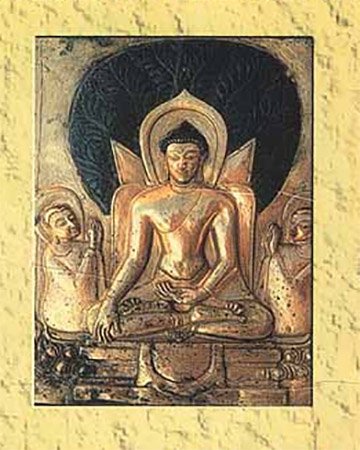The Mahavastu (great story)
by J. J. Jones | 1949 | 502,133 words | ISBN-10: 086013041X
This page describes thirty-three (trayastrimsha) which is Chapter III-e of the English translation of the Mahavastu (“great story”), dating to the 2nd-century BC. This work belongs to the Mahasanghika school of early Buddhism and contains narrative stories of the Buddha’s former lives, such as Apadanas, Jatakas and more..
Chapter III-e - Visit to other worlds (5): Thirty-three (trāyastriṃśa)
The venerable Mahā-Maudgalyāyana often went on a visit to the Trāyastriṃśa[1] devas.
There he sees the Trāyastriṃśa devas, who are virtuous, mighty, long-lived, strong, and enjoying great well-being. (32) They have the devas’ span of life, their strength, their bliss, their sway, their retinue, and the forms of the devas, their voice, smell, taste, touch, their garments and their ornaments, and their sensual pleasures. They are self-luminous, travel through the air, live in happiness, and go wheresoever they wish. They have plenty of food, abundant meat and drink. In the bejewelled mansions of the devas, in the eight great parks,[2] Vaijayanta, Nandāpuṣkariṇī, Pāripātrakovidāra, Mahāvana, Pāruṣyaka, Citraratha, Nandana, and Miśrakāvana, and in other bejewelled mansions, endowed and gifted with the five modes of sensual pleasure, they disport, enjoy and amuse themselves. Śakra, too, lord of the devas, attended by eight thousand Apsarases,[3] and endowed and gifted with the devas’ five modes of sensual pleasure, disports, enjoys and amuses himself in his palace Vaijayanta.
The elder Maudgalyāyana saw all this prosperity of the Trāyastriṃśa devas, their deva bliss, their fair deva city, the seven-jewelled splendour of the fair deva city, and the holy assembly hall of the devas all radiant with the sparkle of beryl and extending a thousand yojanas. There the Trāyastriṃśa devas and Śakra, the lord of the devas, abide and dwell together immersed in the affairs of devas, and are seen from outside in the assembly hall of the devas. The Trāyastriṃśa devas, too, as they dwell in their sacred assembly-hall look out on the whole of the fair deva city.
When he had seen all this prosperity of the Trāyastriṃśa devas, the elder came to the Jeta Grove and described it at length to the four assemblies. “Thus,” said he, “do beings who are reborn among the Trāyastriṃśa devas, as a maturing of their good karma, attain the bliss of devas. But this bliss, also, is impermanent, unstable, and liable to change. For when they pass away from that state these beings are reborn in hell and as brutes and ghosts. Therefore one must strive after knowledge, win it, (33) be enlightened, be fully enlightened, perform the right deed, live the holy life, and commit no sin in this world. Thus I declare.”
Footnotes and references:
[1]:
See p. 25.
[2]:
In the tradition only the last four (in Pali—Phārusaka, Cittalatāvana, Nandana and Missakāvana) are, properly speaking, gardens or parks. Vaijayanta is the name of Śakra’s palace, as immediately below. Pāripātra (which Senart so prints, although two of the MSS. have °yātre and the usual Sanskrit is pāriyātra) is the Pali pāricchattaka, a tree which grew in the Nandanavana as the result of the Koviḷāra (Kovidāra) tree planted by Magha (see pp. 26n, 131n) outside the Sudhammāsāla. The compiler is obviously hazy about the tradition here, and, therefore, we are justified in taking the names of these two trees as providing the name of one park, although Senart prints them as two separate names, making pāripātra the second element in the compound name Nandāpuṣkariṇīpāri°. The name of the second park is then Nandāpuṣkariṇī, which, strictly speaking, is the lotus-pool in the Nandanavana.
[3]:
The nymphs of Indian mythology.
